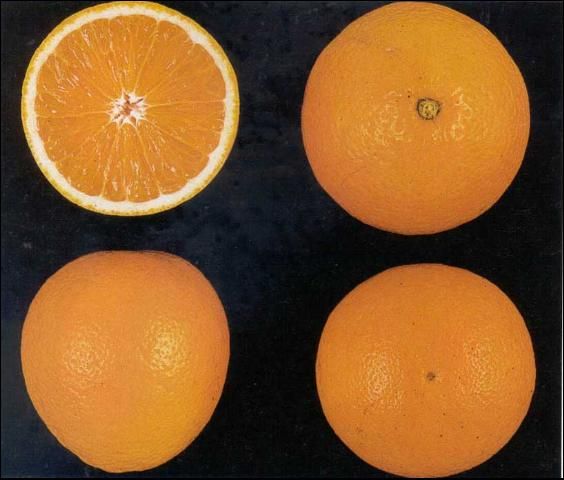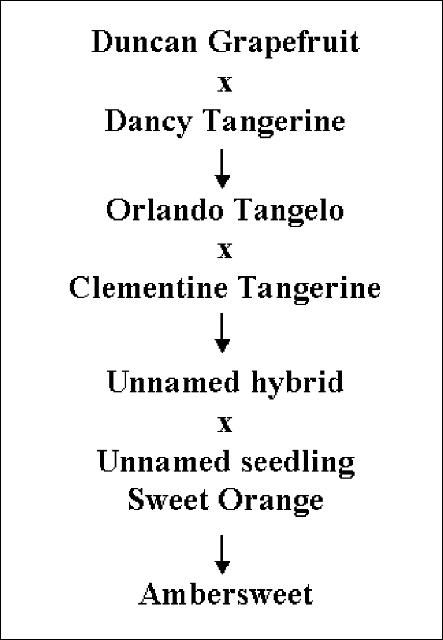The Ambersweet (Figure 1), while classified as an orange for both fresh and processing purposes, is actually a rather complex citrus hybrid. Developed by Dr. C. J. Hearn of the United States Department of Agriculture Horticultural Research Station in Orlando, Ambersweet is a hybrid of Clementine tangerine by Orlando tangelo crossed with a seedling mid-season sweet orange. Since one of the parents was part tangelo (a tangerine-grapefruit hybrid) Ambersweet would be 3/8 tangerine, 1/8 grapefruit and 1/2 sweet orange as shown in Figure 2.

Credit: UF/IFAS CREC

Credit: UF/IFAS CREC
The actual cross which resulted in the production of this cultivar was made in 1963, and after limited scrutiny and evaluation, Ambersweet was named and released in 1989.
Fruit Characteristics
Most Ambersweet fruit are medium sized with a diameter of 2½ up to 3¾ inches. The color of both the peel and flesh is quite good for an early orange and makes the fruit quite appealing. The shape of the fruit is somewhat unique, being tapered at the stem end with a slightly pear-like overall shape. The peel is thick and tends to be rather pebbly in texture. Ease of peeling is good for eating out of hand. Seed numbers may vary greatly with as few as 0 to 30 or more seeds per fruit. Fruit produced on trees in solid plantings of Ambersweet are likely to be nearly seedless, while trees in mixed plantings are usually seedy due to the influence of cross-pollination.
Yields of Ambersweet have proven to be commercially unsatisfactory and many, if not most, plantings have been removed or topworked to more desirable varieties.
The fruit matures in October most years in Florida and is harvested through December and in some years even into January. Peak quality is attained in November and December most seasons. Low yields and poor juice quality have relegated this variety to the dooryard.
Tree Characteristics
Ambersweet trees are moderately vigorous and tend to be upright in shape. The foliage is usually fairly dense. Young shoots may have small thorns. The trees have shown moderate cold-hardiness but are not greatly different than other early oranges. The fruit should be fully mature in most years before the danger of serious cold weather which would allow for removal of the crop before danger of freezing temperatures.
Ambersweet trees were evaluated on Cleopatra mandarin, sour orange, Carrizo citrange, and rough lemon rootstocks prior to the cultivar release. Rough lemon produced higher yields in the 10-year evaluation period, but fruit quality was best on Cleopatra and sour orange. Limited field observations of Ambersweet on Swingle citrumelo rootstock suggest that this is also a satisfactory rootstock.
Cultivation
Routine cultural practices should not vary from those recommended for other citrus trees.
Field observations have produced concerns about certain characteristics, and they are discussed below:
- Some Ambersweet trees in various locations (and usually on Swingle rootstock) have been slow starters. Trees sometimes languish for several years before commencing anticipated growth normal for a young citrus tree.
- Ambersweet (as well as some other citrus types) seem to be quite attractive to mites that attack citrus, especially the citrus rust mite. Extra control measures may be necessary for Ambersweet over and above those normally required for most other citrus.
More Information
Additional information on the Ambersweet can be found in the following publications:
Hearn, C. Jack. 1989. "Yield and Fruit Quality of Ambersweet Orange Hybrid on Different Rootstocks." Proc. Fla. State. Hort. Soc. 102:75-78.
Hearn, C.J. 1990. "Degreening, Color-add and Storage of Ambersweet Orange Fruit." Proc. Fla. State. Hort. Soc. 103:259-260.
Saunt, James. 2000. Citrus Varieties of the World. Sinclair International Limited, Norwich, England. p. 22.